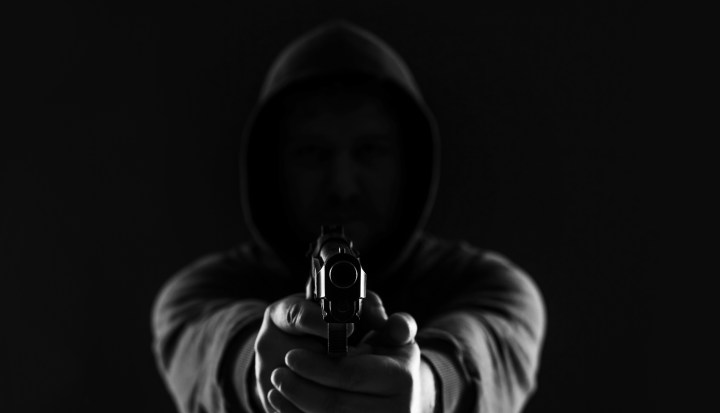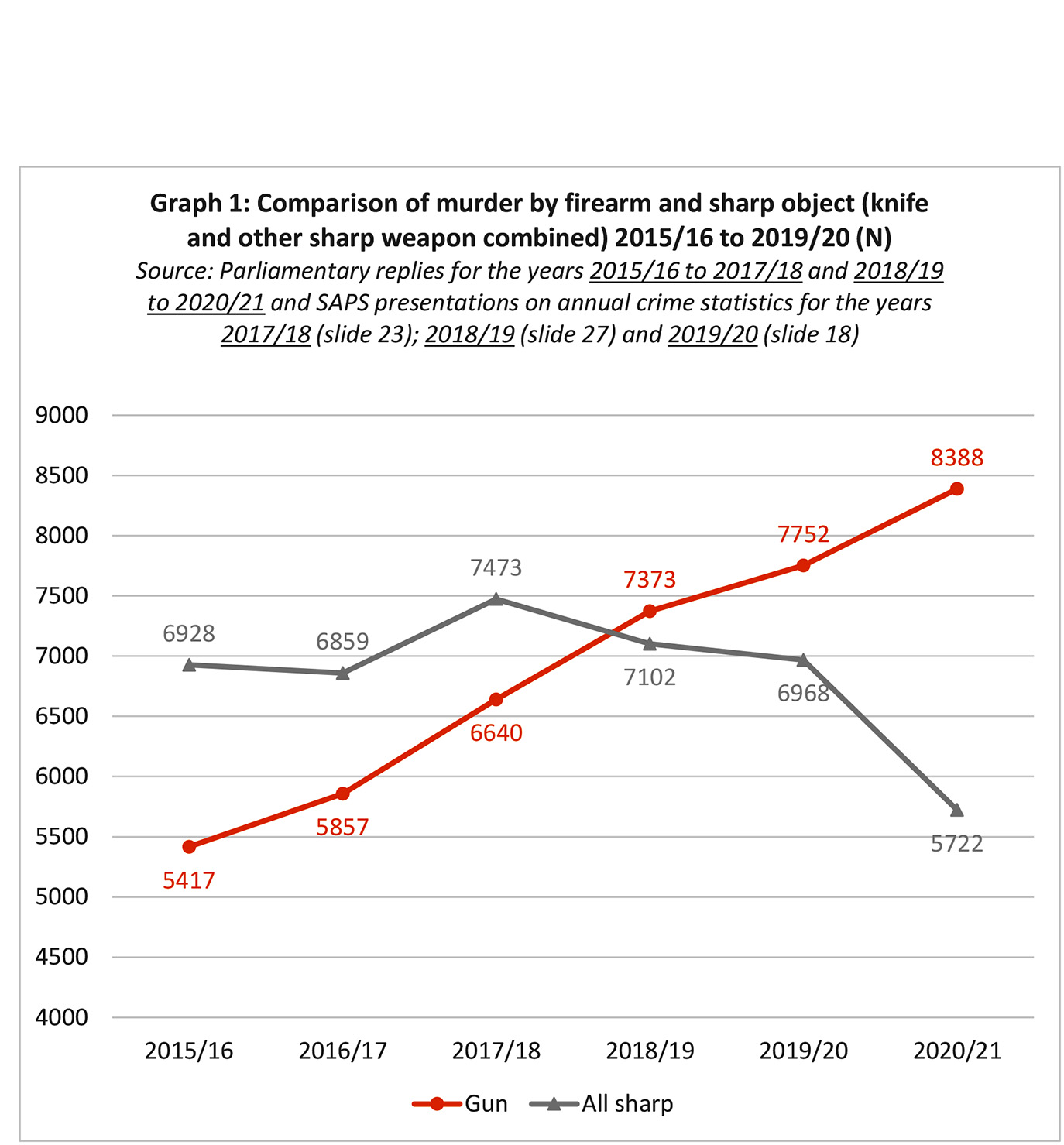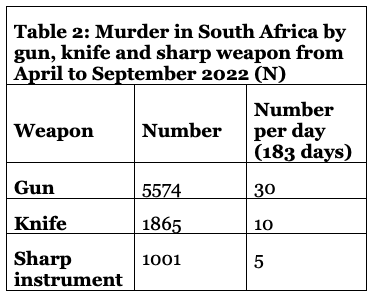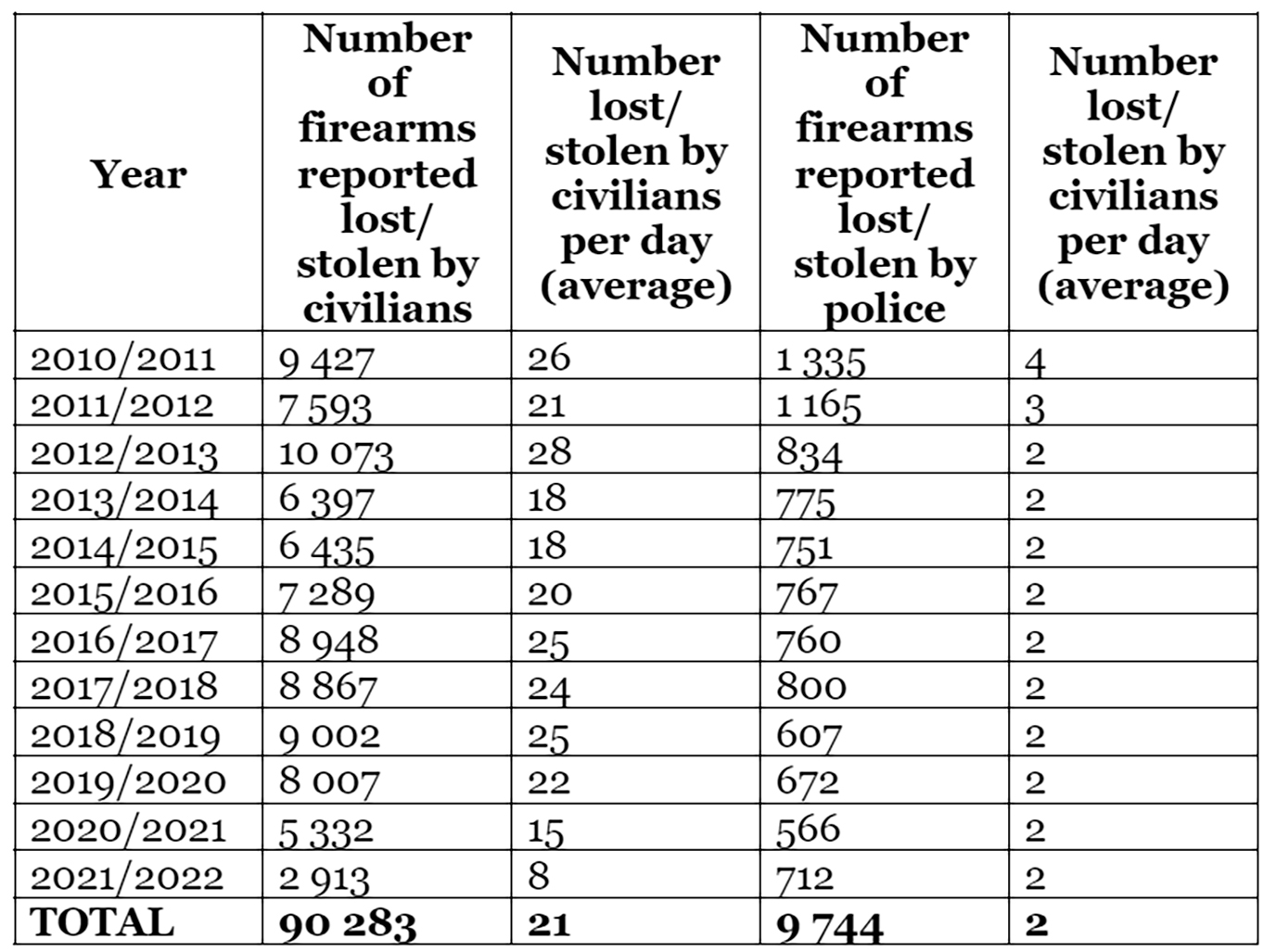SILENCING THE GUNS
Guns and gun violence in South Africa — the evidence

A look at the claims and the facts.
Maverick Citizen earlier this week published a guest editorial by Gun Free SA’s director, Adèle Kirsten. In response, we received a number of complaints by gun advocates alleging factual inaccuracies in the article. To set the record straight, we invited Kirsten to address the issues raised and provide sources and evidence to support her claims. – Mark Heywood, Maverick Citizen Editor
Read more in Daily Maverick: “30 people die by the gun every day in SA – it’s time to stop the violence”
Claim 1: Knives – not guns – are the leading murder weapon in South Africa.
Fact: Guns are the leading murder weapon in SA, and have been since at least 2015/16 (when information on weapon use was first published).
After not publishing this for a number of years, information on the weapons used in murder was provided for the years 2015/16, 2017/18, 2017/19 and 2020/21 in response to two parliamentary questions.
It was also provided in SA Police Service (SAPS) presentations on annual crime statistics for the years 2017/18 (slide 23); 2018/19 (slide 27) and 2019/20 (slide 18).
From this information, we can see that more people were murdered with guns than knives from as early as 2015/16 (see Table 1).

Further, in 2018/19, firearms replaced all stab-related deaths (knife and other sharp weapons combined) as the leading weapon used in murder (see Graph 1).

SAPS did not provide information on weapon use in 2020/21, but has provided it for the first two quarters of 2022 (April to June and July to September) Note: Information for April to June 2022 was downloaded from “police recorded crime statistics – Republic of South Africa” on 19 August 2022. A video of the presentation, including slides, is available here: “Police Minister Bheki Cele presents the quarterly crime statistics”.
As summarised in Table 2, the latest quarterly crime statistics show that 5,574 people were murdered with a gun (averaging 30 people a day over 183 days) and 2,866 were stabbed (1,866 with knives and 1,001 with other sharp weapons, e.g. broken bottles, averaging 15 sharp-wound deaths a day).

Claim 2: Licenced gun owners and businesses (such as trainers and dealers) are responsible and law-abiding.
Fact: There is evidence that thousands of licenced gun owners and businesses have broken and continue to break the law.
Licenced gun owners have not always complied with the Firearms Control Act, 2000 (FCA). Failures include:
Not relicensing firearms under South African law:
The transitional provisions of the FCA gave existing gun owners with “green licences” issued under the 1969 Arms and Ammunition Act a period of four years to renew their licences under the stricter provisions of the FCA, starting in 2005.
In 2009, as the transitional provisions were coming to an end, the North Gauteng High Court granted an interim court order under which “green” licences remain valid pending the final outcome of an application to have certain sections of the FCA declared unconstitutional.
Although this ruling protects gun owners with “green licences” from being in possession of illegal firearms, more than one million firearm owners have chosen to not comply with the law of South Africa by reapplying for licences under the FCA, despite this being the responsibility of law-abiding citizens.
Failing to renew licences as required by law
In 2016, SAPS issued a directive to standardise the firearm licence renewal process, which had been unevenly enforced and complied with around the country.
According to SAPS (2015-2016 Annual Report, p. 111), the directive was “prompted… by individuals and businesses not applying to renew their licences”.
Figures from SAPS revealed an overall compliance rate of just 67% with section 24 of the FCA (which deals with licence renewals): of the 191,488 firearm licences liable for renewal in the 2015/16 financial year, 128,419 applications were received (source: SAPS 2015-2016 Annual Report, p. 111).
In addition, gun-related business have committed a range of criminal acts – some of the more high-profile cases are summarised below:
High-profile South African examples of crimes committed by gun-related businesses
Accredited firearms training institutions:
- Police close illegal KZN firearms training academy: A 2015 joint police operation swooped on a Richards Bay firearms training academy which had been running illegally since 2009, making all firearms certificates issued by the academy invalid (Police swoop on firearm training academy).
- Journalist buys fake gun proficiency certificate: The secretary of the South African Professional Firearm Trainers Council (which, on 6 March 2015, was appointed as the national body responsible for ensuring the quality of firearms proficiency certification) was caught on camera selling a proficiency certificate to a journalist without her having received any training (SABC exposes the fraudulent sale of firearm proficiency certificates).
Accredited firearms dealers:
- Hawks investigate one of South Africa’s biggest gun dealers for large-scale corruption: In 2013, Dave Sheer Guns was identified by the Hawks (the South African Police Services’ Directorate for Priority Crime Investigation) as being at the centre of a large-scale corruption racket involving bribery and creating fraudulent permits to export weapons and ammunition to conflict countries including Sudan and Syria (Firearm shop suspects nabbed at airport). According to a media report (SA man ‘sold conflict arms’), an employee claimed that she paid bribes to police officers and lied to clients as part of her job as a sales manager. To date, there have been no arrests.
- Gun dealer stands trial for helping sell stolen guns to gangsters: Alan Raves, a Vereeniging-based gun dealer, is currently standing trial as an accomplice to Christiaan Prinsloo, the ex-police colonel sentenced to 18 years for selling guns earmarked for destruction in police stores to gang leaders in the Western Cape (Vereeniging arms dealer to stand trial for alleged role in trafficking police guns to criminal gangs).
- Unlicenced guns recovered from gun dealer: 323 unlicenced guns were recovered from a firearms dealership in Pretoria during a raid by the Hawks national bureau for illegal firearms control and priority violent crime. Moreover, while the dealership had various firearms registered in its name on the enhanced firearms registration system, these could not be accounted for (More than 300 firearms seized in Hawks raid on firearms dealership).
- Gun dealer charged with murder after supplying guns to gang: A Durban firearms dealer was charged with eight murders and five attempted murders in Cape Town, as well as the illegal supply of firearms to Cape Town gangs. The list of weapons involved take up several pages – and range from Glocks to shotguns (Durban firearms dealer charged with multiple murders in Cape Town).
These are dismal shows of non-compliance and undermine claims that gun-owners and businesses are responsible and law-abiding.
Claim 3: The biggest source of illegal guns is 1) guns smuggled into South Africa from neighbouring countries and/or 2) arms caches from SA’s liberation struggle and/or guns stolen from the police.
Fact: Legal guns owned by civilians and the state are the biggest source of illegal guns in SA.
Recently published research into Southern Africa’s illegal firearms market by the Global Initiative Against Transnational Organised Crime found that conflict guns and cross-border trade are very small contributors to SA’s illegal firearms pool:
- Conflict arms: Most would now be relatively old and, unless stored and maintained, would no longer be effective. Indications are that, while some of these weapons may still be in use, over the past 15 years there has been a gradual shift to more modern firearms, which are now playing a more prominent role in South Africa’s illicit firearms economy.
- Cross-border trade: Whether as a result of initiatives like Operation Rachel or other factors, by the late 1990s, the number of firearms being smuggled into South Africa decreased significantly. For instance, police statistics show a decline in the number of illegal weapons seized at ports of entry since 2009/10 (when 179 illegal firearms were recovered, while 49 illegal firearms were recovered in 2018/19).
According to the 2021 report, the most significant source of illegal guns in SA is legal firearms owned by civilians and the state, which includes the police, military and other state departments.
SAPS annual reports (figures copied in Table 4) show that civilians report losing (through negligent loss or criminal theft) 10 times more guns than the police.

Claim 4: Legal gun ownership does not lead to an increase in murder.
Fact: Legal gun ownership increases the pool of guns and as guns become more available, gun-related deaths increase.
Because legal guns are the biggest source of illegal firearms in SA, reducing this pool and tightening controls over it will help stop guns leaking into criminal hands.
Peter Squires has researched the impact of gun availability on a country’s level of violence. He has shown how gun violence is influenced by a country’s “gun control regime”, which includes policing and criminal justice systems, systems of political accountability, welfare safety nets, comprehensive education provision and cultures of trust and confidence.
In wealthy countries with strong systems, gun availability increases the risk of suicide, while in countries like SA, which have high levels of socioeconomic inequality and weak systems, gun availability increases the risk of murder.
A number of other meta-analyses (which analyse many studies) have shown the link between gun control and gun violence.
Julian Santaella-Tenorio reviewed 130 studies from 10 countries exploring the associations between firearm-related laws and firearm homicides, suicides and unintentional injuries/deaths, and found that the implementation of laws that restricted firearm availability were associated with reductions in firearm deaths. DM/MC


















 Become an Insider
Become an Insider
There must be a problem with table 4 , where is table 3 ? AND the headings doesn’t make sese, which column shows Police statistics
Once again, dear Adèle blurs the lines between the legal and the illegal – which is exactly why her arguments do not withstand scrutiny. She does not properly distinguish between the crimes committed via legal versus illegal firearms, as well as the number of crimes committed by illegal versus legal firearm owners.
In response:
Claim 1 – How many of the tabulated murders were committed by legally licensed firearm owners? How many murders were committed using weapons lost by the SAPS?
Claim 2 – Legal owners not relicensing their firearms: As the High Court declared all the “green licences” valid pending the outcome of a further application, such licences remained valid until the time of that outcome. There is accordingly no need to relicence if your licence is valid. Illegal acts by firearm-related businesses: How many compliant firearm dealers, who ply their trade legally everyday, exist compared to illegal dealers? The statistics will favour the former.
Claim 3 – It is a fact that there are more firearms in public hands than there are in the SAPS arsenals – because the number of members of the public dwarfs the number of police officers. Ergo, it is obvious that more weapons would be lost/reported stolen by the public than the police.
Claim 4 – None of the studies speak to whether levels of other crimes decreased due to increased firearm ownership. Further, how many legal versus illegal firearm owners were murdered?
The spotlight must be placed on ILLEGAL gun crime.